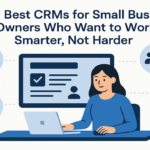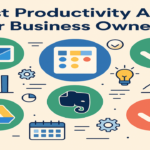So, what is business development? And how does it interact with other departments? Learn all about business development via this guide.
Corporation development is the value production for an organization or business in its most basic form to boost profitability. This includes coming up with new ideas, initiatives, and activities. Business development aims to make informed business decisions that provide value to companies and customers, not only to raise profits.
What is business development?
The most precise definition of business development is a set of actions and processes to develop and implement sustainable and lucrative growth prospects within (and across) firms. Most firms, however, use the term differently in practice, depending on what they need that function to do for them. For example, in a SaaS scale-up, Business Development typically entails a lot of cold outreach to new clients.
Business Development in a large, global corporation, on the other hand, may do market research in preparation for a new market entry or a new product line. Regardless of their variations, business developers in all firms have one purpose: to identify and implement new growth prospects.
“Growth opportunities” is the essential word here. In most cases, “new prospects” refers to anything other than “new clientele.” It also contains the following:
- Getting new partners
- Entering new markets
- Developing new products
The difference between business development and marketing
Marketing develops, communicates, and delivers valuable offerings to customers or strategic partners. It is critical to identify all available growth opportunities.
Your business professional will seek ways to appeal to target markets. At the same time, your marketing team will modify their marketing talents and money to develop the material that enables that target appeal to occur, resulting in a complementary partnership and long-term connections.
Unlike content generation, which can be easily outsourced to freelancers, agencies, or even college writing services, a development expert should be intimately familiar with your business.
Both departments must work together to achieve successful marketing based on the creation and research that informs the future marketing content.
What are the skills required for business development?
B.D.R.s work with sales and marketing departments in general, assisting them in achieving their objectives. This necessitates a rare combination of marketing, communication, and sales skills:
- Marketing skills: While business development executives are focused on developing relationships, they must also be able to promote their brand, gather in-depth market research, comprehend the competition, and find and educate new target prospects. As a result, this business development and marketing activities have a lot in common.
- Communication skills: Strong communication and listening skills are required when calling prospects, establishing long-term relationships with strategic partners, listening to potential clients’ problems, and providing vital information to stakeholders. It’s challenging to succeed in business development if you can’t communicate effectively and clearly.
- Sales skills: Prospecting, qualifying leads, maintaining connections with both new and existing clients, and updating sales customer relationship management databases on all sales activity, including follow-ups, are abilities that B.D.R.s typically share with sales professionals. B.D.R.s generally collaborate closely with sales team members to move prospects through sales.
A good B.D.R. is similar to a C.E.O. if you think about it. To win opportunities and stay ahead of the competition, B.D.R.s must think swiftly and strategically. As B.D.R.s, we must approach our work with an entrepreneurial and visionary mindset. We are, after all, the initial point of contact for potential clients and partners. As a result, we’re the ideal people to gather market intelligence firsthand. This job may be incredibly effective when coupled with other teams — particularly the sales team, generally entrusted with seizing chances.
What is business development role?
- Look at customer interaction with a product to establish the issue.
- Talk to the product development team to create the product the client wants.
- Work with marketing to develop the new branding and rollout.
- Generate potential leads before passing them on to the sales department.
- Look at new strategic partnerships to help reach the customer.
Business development vs. sales
If business development is the process of determining where new items will fit into a new market, sales are successfully selling the product to that market. You can’t sell the product unless you do the development work first, but you can’t make money or grow your company unless you sell its message to potential customers.
The customer, the product & the market
The development arm of a company will focus on identifying your target customer/s and determining what product they want, then designing the product and ensuring that it fits into the present market.
Finally, the pros would ensure that existing clients’ referrals are maximized.
What is business development strategy?
Not all forms of business development have the same impact. In truth, many professionals’ activities are pretty opportunistic and tactical. Many seller-doers are particularly guilty of this.
They searched for something quick and uncomplicated that would yield short-term results, caught between the pressures of client work and an urgent need for new business. Of course, this isn’t a simple strategy.
The alignment of business development processes and procedures with your company’s strategic business goals is known as strategic business development. Strategic business development aims to attract ideal clients for your most essential services by making brand promises you can keep.
Choosing which objectives to pursue and which techniques to use to grow a new business is high risk. A well-executed plan can result in high levels of growth and profitability. A poor plan can stifle growth and frustrate critical employees.
Despite this, many businesses fail at this crucial stage. They rely on tradition, anecdotes, and fads — or, even worse, “this is how we’ve always done it.” We’ll go through how to create a strategic business development strategy in a later part. But first, let’s look over some of the methods that could be included in that strategy.
The importance of a good business development strategy
A solid business development strategy is the framework that teaches your team how to locate and generate high-value leads that will help the company achieve its long-term objectives. Your employees may struggle to identify those qualifying prospects if you don’t have a strategy in place, or they may waste time developing relationships with prospects who will never convert if you don’t have one.
The definition of business development is broad, and it differs from one organization to the next. Professional service businesses commonly use a three-tier funnel strategy to create new revenue. Attracting Prospects and Building Engagement are the first two steps, traditionally marketing functions. Turning Opportunities into Clients, the third and final stage is generally a sales function. The company development strategy in this structure would be to seek out new sales and distribution channels and new marketing partners. This is an example of long-term company planning.
Business development process
There are four main stages to creating a firm, reliable business development strategy for your organization.
1. Identify your audience
To establish a business development strategy that provides optimal growth and profit potential, you must first identify your ideal audience. Concentrate on specific companies, industries, or individuals who will help your company grow. Aim for quality rather than quantity: a large audience isn’t always required, but a high-performing one is.
It’s important to remember that successful business development takes time. It can take months, if not years, for a solid relationship to transform into a sale. In the same way, undesirable possibilities will not emerge after your first meeting. This is why it’s critical to pinpoint your particular target market so you don’t waste time cultivating a relationship with an unqualified lead who will never convert.
2. Perform market research
After you’ve determined who your target audience is, you’ll need to learn everything about them. You should be able to answer the following questions about them before you start encouraging them to collaborate with you:
- What are their primary issues?
- What services do they need?
- What is their approach to problem-solving currently?
- How can your product or service improve their current situation?
After you’ve answered these questions, you may start analyzing your competitors. Determine what distinguishes you from your competition and use that distinction as a competitive advantage when presenting your value to prospects.
3. Determine the appropriate channels
You may begin to identify the channels you will use to attain your aim once you have placed your target audience, learned everything there is to know about them, and formed a plan of action to set you apart from your competition. This entails determining your overall revenue targets for the year and laying out the exact tactics you’ll employ to achieve them: the top business development methods and approaches you can use to generate new business cover these channels.
4. Define S.M.A.R.T. goals
Set S.M.A.R.T. (specific, measurable, attainable, relevant, and time-related) goals for each channel to help you monitor and track your success. Although your overall business development goal does not have to be directly linked to creating profit and revenue, it should have a component to bring new prospects into your sales funnel.
Top business development strategies
Let’s look at some of the most common business development strategies and how they stack up with today’s buyers.
Networking
The most often used business growth approach is undoubtedly networking. It’s based on the idea that professional services purchasing decisions are based on connections and that face-to-face networking is the best method to form new ones.
Many relationships develop in this manner, which is true in many cases. You can also build a new business by networking with your target demographic. However, there are certain limits. Today’s buyers are pressed for time, and networking takes time. It may be somewhat costly when you include travel and time away from the business.
On the cost and time front, newer digital networking solutions can aid. Even social media, though, needs a time and attention commitment.
Referrals
Referrals, which are closely related to networking, are frequently viewed as the mechanism that converts networking and client satisfaction into new business. You build a relationship with someone, and they refer you to a new business. Clients who are satisfied return the favor.
Recommendations do occur, and many businesses rely on them for most of their revenue. Referrals, on the other hand, are a passive activity. They count on your clients and relationships to find potential candidates for your services and make the appropriate referrals.
The problem is that referral sources aren’t always aware of how you can assist a client. So many referrals aren’t a good fit for your skills. Other well-matched referrals go unmade because your referral source misses an excellent prospect when it comes their way.
Finally, many potential clients will dismiss your firm before speaking with you. According to a recent study, the figure is over 50%.
There are also new digital tactics that help speed up referrals. The idea is to make your area of expertise more visible. This encourages people to create better referrals and broadens your referral network beyond clients and a few business acquaintances.
Sponsorships and advertising
Is it possible to generate new business by sponsoring events and advertising? If it works, it will solve a lot of problems. No more scrounging time from overworked billable professionals.
Regrettably, the outcomes on this front are not promising. Traditional advertising has been linked to slower growth, according to studies.
Advertising yields results only when paired with other strategies, such as speaking at an event. Well-targeted digital advertising appears to be the most promising advertising technique. Firms can use this to get their messages and offers in front of the relevant people for less money.
Outbound telephone and mail
For decades, professional services firms have used phone calls and direct mail to reach potential clients. You should expect to find new prospects that can be developed into clients if you target the correct organizations and roles with a suitable message.
There are a few significant drawbacks to these tactics. To begin with, they are pretty costly, so they must be just right to be effective. Second, if you don’t catch the prospect at the correct time, your offer may lack attractiveness and, as a result, have no impact on business growth.
The idea is to present an enticing offer to a highly qualified and responsive list. This is a difficult combo to master.
Thought leadership and content marketing
Demonstrating your expertise and showcasing how it can solve client problems is key to making your knowledge and experience visible to potential buyers and referral sources. Traditionally, professionals have relied on methods like writing books, articles, and speaking engagements to grow their businesses. However, the landscape has evolved with technological advancements.
In today’s digital age, establishing expertise with a target market is quicker and easier than ever before. Search engines have democratized visibility, allowing even lesser-known individuals and businesses to gain recognition beyond their local reach. Webinars have made public speaking more accessible, while blogs and websites ensure a constant presence. The integration of video and social media further expands the potential audience.
Yet, with increased accessibility comes heightened competition. Businesses now face the challenge of standing out amidst a sea of experts, many of whom were previously unknown. This raises the stakes for your business development strategy.
Combined strategies
Combining several corporate growth techniques is frequent. Networking and recommendations, for example, are frequently utilized in tandem. A combination strategy makes excellent sense on one level. One strategy’s strength can compensate for another’s flaws.
However, there is a secret threat. A strategy must be implemented entirely to perform at its best. It’s possible that attempting to adopt too many different tactics will result in you never fully implementing any of them.
No matter how lofty, good intentions aren’t worth much in terms of business success. The plague of effective business development is under-investment, a lack of follow-through, and inconsistent effort.
Implementing a simple strategy entirely is far more effective than experimenting with a more complex one. Better results are achieved by using fewer pieces that are skillfully executed.
After that, we’ll look at the techniques needed to put a high-level strategy into action. But first, there’s some misinformation to clear up.
Business development strategy vs. tactics
It’s not always easy to distinguish between strategy and tactics. Networking, for example, might be viewed as a component of a larger corporate development plan or as a way to boost the impact of a thought leadership strategy. To be sure, it’s perplexing.
The distinction, in our opinion, is between focus and intent. If networking is a part of your business development strategy, you should concentrate on making it more effective and efficient. You’ll choose strategies that will make networking more effective or more accessible. You could try another marketing strategy and then abandon it if it does not assist you in implementing your networking strategy.
If networking is just one of several techniques, your decision to use it will be based on how well it fits your overall strategy. Tactics and approaches can be adjusted and tested. On the other hand, strategy is a deliberate decision that does not alter from day to day or week to week.
Measuring the impact of business development efforts
The sales indicators for a business development team will differ depending on the company’s sales cycle. Because the role’s primary duty is to generate new sales prospects, one of the most straightforward methods to quantify this information is to look at the BDR-influenced sales pipeline or the number of possible transactions generated from business development efforts.
Many B.D.R. teams have quotas that correspond to the company’s overall revenue objectives. Business development must consistently generate a healthy pipeline to meet revenue goals (which are the sales team’s responsibility).
Prospecting activities (cold calls and outbound emails), appointments scheduled, and the number of sales funnels generated are popular ways to track B.D.R. activity. However, KPIs vary by firm. CRM software is used to store and track all of this information.
Business development tools
A key factor of development in a business is saving time and giving professionals enough time to focus on key business areas.
- Close
- HubSpot
- NetHunt CRM
- Amelia
- Pipedrive
- Streak
- Copper
- Prezentor
- Calendly
- Proposify
- DottedSign
- EngageBay
- Trello
- Appointy
Tools for the development professional include completely integrated sales and marketing CRMs, sales management tools, and software that syncs with your email and allows you to handle documents on the move.












